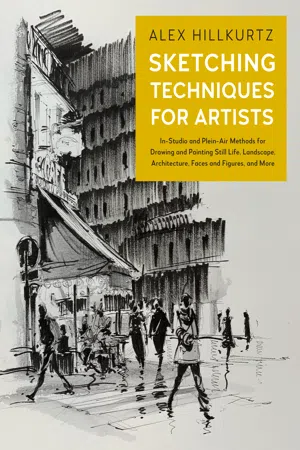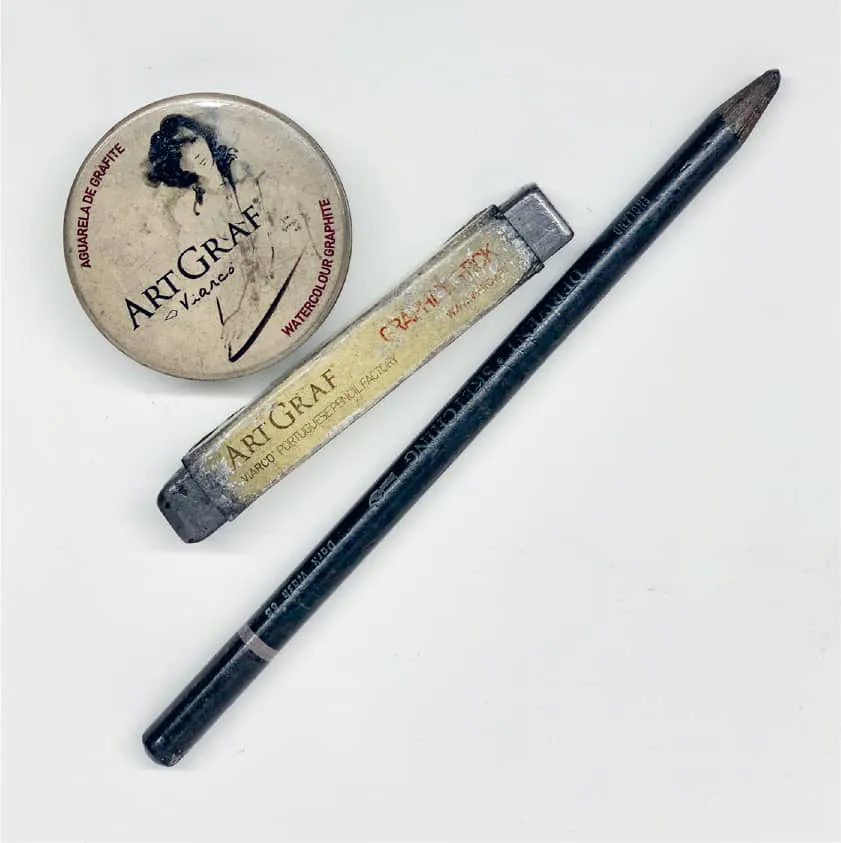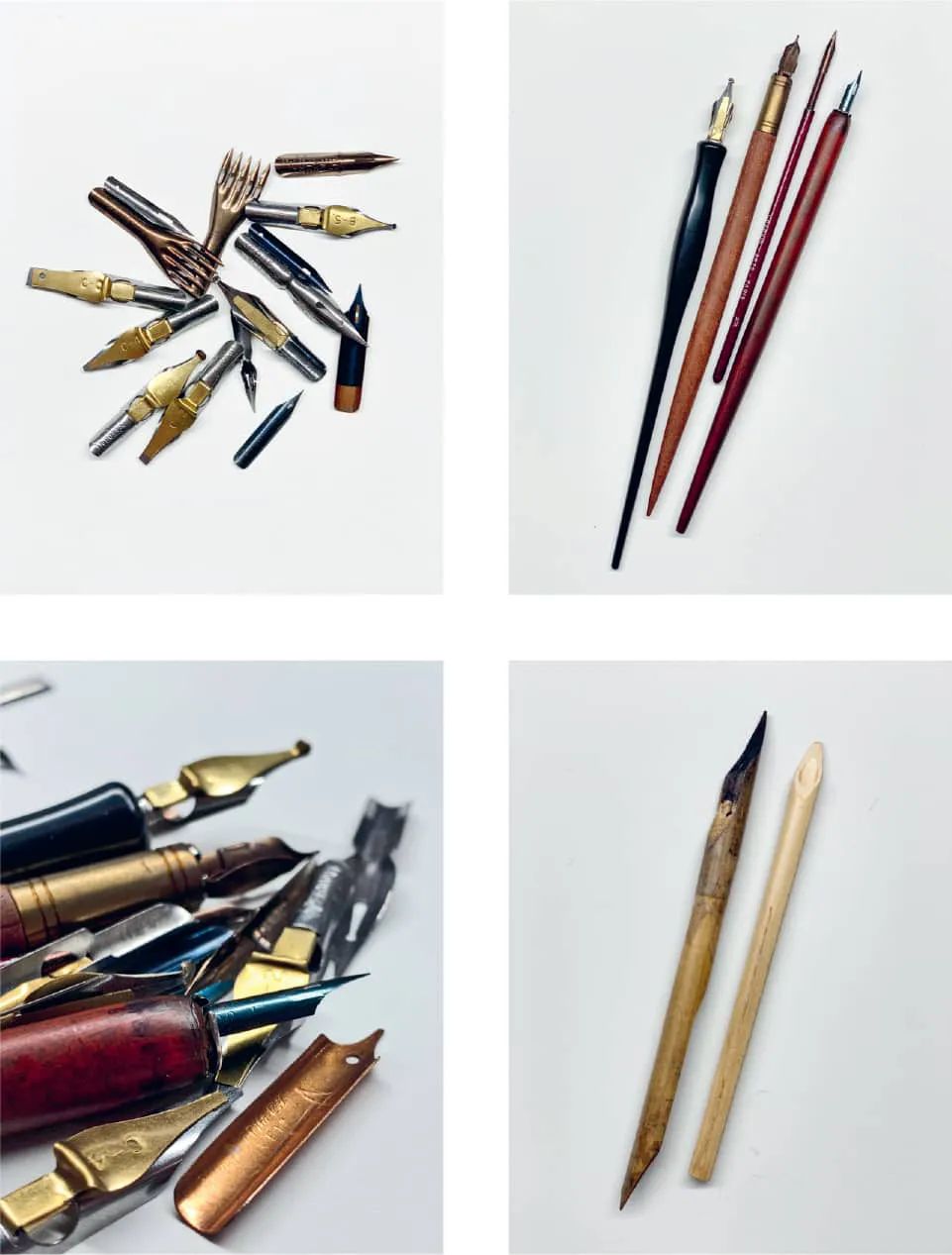
eBook - ePub
Sketching Techniques for Artists
In-Studio and Plein-Air Methods for Drawing and Painting Still Lifes, Landscapes, Architecture, Faces and Figures, and More
- 160 pages
- English
- ePUB (mobile friendly)
- Available on iOS & Android
eBook - ePub
Sketching Techniques for Artists
In-Studio and Plein-Air Methods for Drawing and Painting Still Lifes, Landscapes, Architecture, Faces and Figures, and More
About this book
Learn dynamic sketching and watercolor techniques for creating cityscapes, landscapes, figures and faces, still lifes, and more, enhancing the story you want to tell with form, line, and color.
Discover incredible methods and tips for creating dramatic street scenes and vivid landscapes, and capturing dynamic figures and graphic architectural details. Artist Alex Hillkurtz—a top Hollywood storyboard artist, international workshop instructor, and Signature Member of the National Watercolor Society—presents fundamental concepts of sketching with pencil and pen for a number of popular genres. Discover simple ways to jot down spontaneous ideas in pencil, capture rough details in ink, and add watercolor for extra depth and interest.
Make sketching more enjoyable by adopting innovative techniques that will make a difference in your practice, and your artwork. No matter your experience or skill level, you’ll benefit from learning:
Discover incredible methods and tips for creating dramatic street scenes and vivid landscapes, and capturing dynamic figures and graphic architectural details. Artist Alex Hillkurtz—a top Hollywood storyboard artist, international workshop instructor, and Signature Member of the National Watercolor Society—presents fundamental concepts of sketching with pencil and pen for a number of popular genres. Discover simple ways to jot down spontaneous ideas in pencil, capture rough details in ink, and add watercolor for extra depth and interest.
Make sketching more enjoyable by adopting innovative techniques that will make a difference in your practice, and your artwork. No matter your experience or skill level, you’ll benefit from learning:
- Compositions that draw the eye
- How to avoid common sketching mistakes
- Ways to create light and shadow to define shapes and add interest
- Successful ways to use negative space
- The importance of perspective in creating depth
- Easy color washes that create drama
Get started today, and fill your sketchbooks with unique drawings and paintings you will be proud of.
The For Artists series expertly guides and instructs artists at all skill levels who want to develop their classical drawing and painting skills and create realistic and representational art.
Frequently asked questions
Yes, you can cancel anytime from the Subscription tab in your account settings on the Perlego website. Your subscription will stay active until the end of your current billing period. Learn how to cancel your subscription.
No, books cannot be downloaded as external files, such as PDFs, for use outside of Perlego. However, you can download books within the Perlego app for offline reading on mobile or tablet. Learn more here.
Perlego offers two plans: Essential and Complete
- Essential is ideal for learners and professionals who enjoy exploring a wide range of subjects. Access the Essential Library with 800,000+ trusted titles and best-sellers across business, personal growth, and the humanities. Includes unlimited reading time and Standard Read Aloud voice.
- Complete: Perfect for advanced learners and researchers needing full, unrestricted access. Unlock 1.4M+ books across hundreds of subjects, including academic and specialized titles. The Complete Plan also includes advanced features like Premium Read Aloud and Research Assistant.
We are an online textbook subscription service, where you can get access to an entire online library for less than the price of a single book per month. With over 1 million books across 1000+ topics, we’ve got you covered! Learn more here.
Look out for the read-aloud symbol on your next book to see if you can listen to it. The read-aloud tool reads text aloud for you, highlighting the text as it is being read. You can pause it, speed it up and slow it down. Learn more here.
Yes! You can use the Perlego app on both iOS or Android devices to read anytime, anywhere — even offline. Perfect for commutes or when you’re on the go.
Please note we cannot support devices running on iOS 13 and Android 7 or earlier. Learn more about using the app.
Please note we cannot support devices running on iOS 13 and Android 7 or earlier. Learn more about using the app.
Yes, you can access Sketching Techniques for Artists by Alex Hillkurtz in PDF and/or ePUB format, as well as other popular books in Art & Art Techniques. We have over one million books available in our catalogue for you to explore.
Information
1
MATERIALS AND TOOLS
Pencil, ink, and paint can be applied to a page in many ways, each with its own purpose and personality. Tools are an extension of your hand, your arm, your imagination, and your soul. We could paint with our fingers, but an endless variety of art supplies have been invented to enhance our abilities and fine-tune our expression. It’s worth spending time playing with these tools and getting used to the way they feel and perform.

A PERSONAL CHOICE
Tools used to express creativity can be a very personal choice. As you become more comfortable with different tools, you’ll find ones that best express what you want to say. For some, a cheap pen with a steel nib is sufficient. Others prefer something more expensive and stylish. Like most art supplies (and tools in general), you get what you pay for. Remember, the best brush is the one you have with you. The best set of paints is what you have with you. You can do a lot with minimal materials.
Pencils, Pens, and Inks
Making marks on paper is at the root of all sketching. Here are some of my favorite tools that get my sketches off to a good start.
PENCILS
I have a soft touch while sketching so I prefer a darker lead. For me, 4B and 6B pencils are best. Because these leads are soft, I use a mechanical pencil to maintain a fine line without constant sharpening. For highlights, I use a white Conté à Paris sketching pencil. For quickly applying shadows, I like the dark wash (8B) Derwent water-soluble sketching pencil and ArtGraf graphite sticks.


INK PENS
Fine liners, fountain pens, dip pens, and bamboo sketching pens—each tool is unique in its feel and application. I carry many options with me when I paint and sketch, so I always have what I need, depending on my mood and the subject I’m drawing.
FINE LINER PENS
Fine liner pens are felt-tip markers that come in multiple widths, so it’s easy to apply variety to your sketch. They’re a wonderfully simple tool for applying a clean, dark line. I use thicker pens for objects in the foreground, and thinner lines for those in the distance. By varying the line weight in this way, you create a sense of atmospheric perspective while using only black ink. Fine liners typically use waterproof ink, so adding washes of color later won’t smudge your line. Sakura Pigma Micron pens sizes 05, 03, and 01 are my favorite.

DIP AND BAMBOO PENS
Dip pens and bamboo sketching pens give a much more dynamic variety of line. These types of pens have been used for thousands of years, and I can’t help but feel the pull of history when sketching with such traditional tools. I use dip pens in the studio as it’s cumbersome to carry a bottle of ink while sketching outdoors. For me, the risk of one unfortunate spill isn’t worth it.

FOUNTAIN PENS AND INKS
My favorite tool for sketching is a fountain pen. These pens are compact, easy to use, and if used properly, won’t leak. I’ve always been drawn to the appeal of fountain pens, with their elegance and artistry of construction.

GET A GRIP
Practice variety in your grip. Just like tennis players have many ways to get the ball over the net, you can build a variety of ways to hold pencils and brushes.
Holding a pencil as if you’re writing a letter is perfect for fine detail, as you use your fingers and wrist to coordinate precise movements. For larger shapes, try an overhand position. This allows the use of your entire arm and shoulder. Your movement will be freer and more expres...
Table of contents
- Cover
- Title
- Contents
- Introduction
- 1 | Materials and Tools
- 2 | General Sketching Techniques
- 3 | Composition
- 4 | Perspective
- 5 | Still Life
- 6 | Landscapes
- 7 | Architecture
- 8 | Figures
- 9 | Watercolor
- Conclusion: Keep Going
- Resources
- Influences
- Acknowledgments
- About the Author
- Index
- Copyright